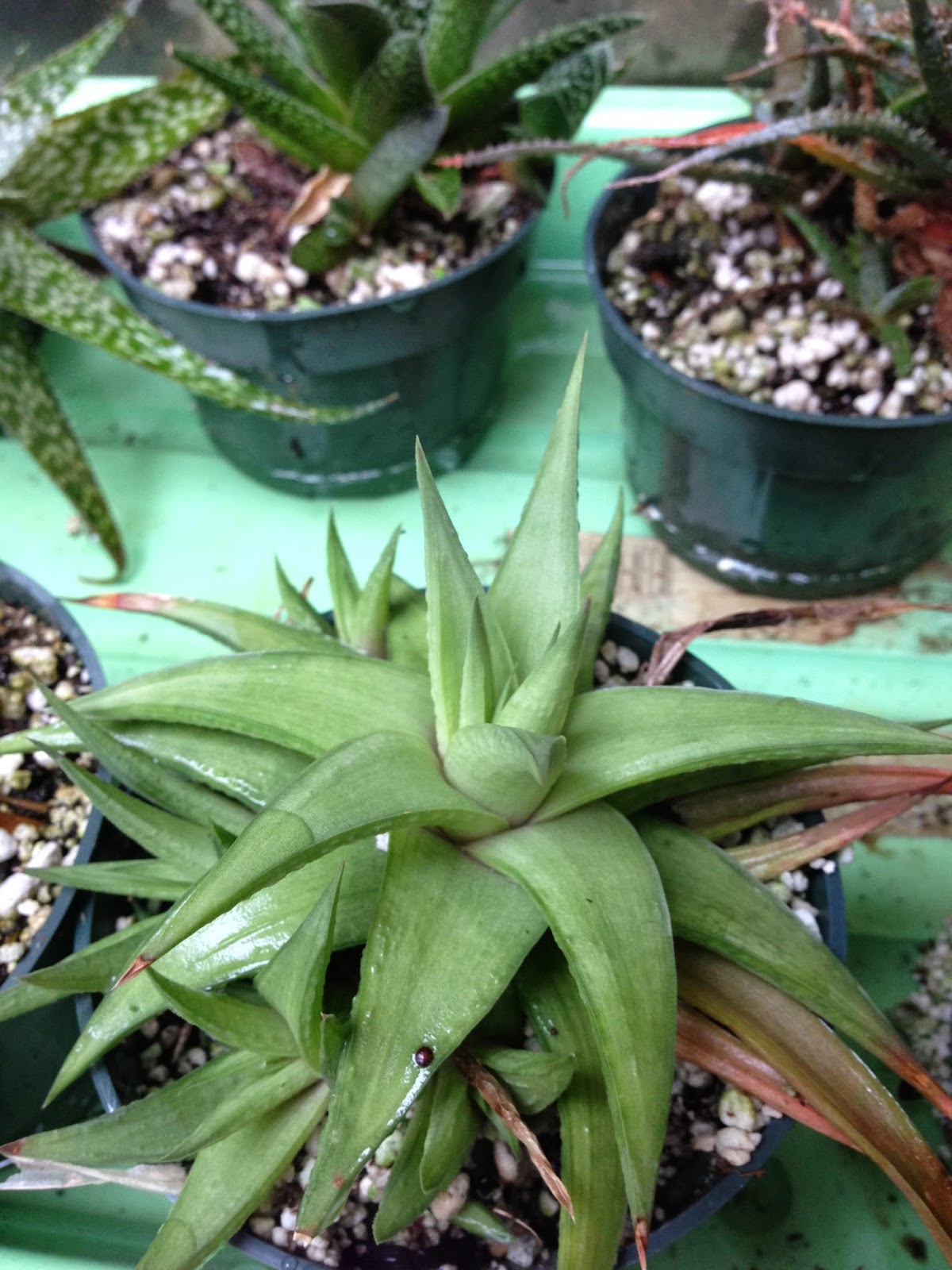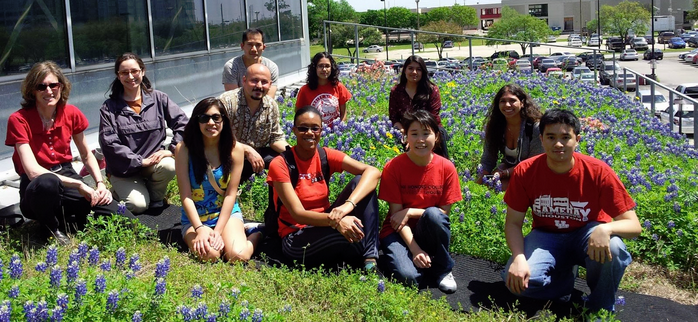We received a donation of three gro pods from Joe Meppelink of the College of Architecture here at UH, and we recently won a mini grant to fund the set-up of those pods! At our last general meeting, we set up the shade cloth and the gro pods, filling them with garden soil, perlite, and Microlife fertilizer.
Later, we added in a few plants. There are three chrysanthemums, a mini rose, thyme, rosemary, lavender, and oregano! We'll slowly add in more plants like mint, gazanias, and bluebonnets.
Wednesday, May 13, 2015
Saturday, May 9, 2015
Sealing the greenhouse
After UH Plant Ops removed the defunct swamp coolers in front of the greenhouse, it left two large holes in the greenhouse where the coolers once connected. Until recently, I simply covered the holes with pool wrap (the blue bubblewrap-like material), but I noticed that cats (and probably other small animals) were able to enter and exit from the holes despite the covering.
So, in preparation of our gro pods and to stop this problem, I filled and plugged the holes. First, I added in four cinderblocks (18''x6''x6'' each) into each hole, stacked 2x2 blocks.
Then, I put PVC pipe through one of the cinderblocks and ran a hose through the PVC.
To fill the hole, I used big gap expanding foam sealant. I had to go back to Home Depot to purchase a second can because one wasn't enough. Of course, use adequate protection, since the foam is sticky and irritating.
Once all the big gaps were sealed, I added steel wool (#12) into the holes of the cinderblocks to prevent any rodents or pests from getting through. I decided to leave the pool wrap on, since it looks better than the yellow foam sealant.
So, in preparation of our gro pods and to stop this problem, I filled and plugged the holes. First, I added in four cinderblocks (18''x6''x6'' each) into each hole, stacked 2x2 blocks.
Then, I put PVC pipe through one of the cinderblocks and ran a hose through the PVC.
To fill the hole, I used big gap expanding foam sealant. I had to go back to Home Depot to purchase a second can because one wasn't enough. Of course, use adequate protection, since the foam is sticky and irritating.
Once all the big gaps were sealed, I added steel wool (#12) into the holes of the cinderblocks to prevent any rodents or pests from getting through. I decided to leave the pool wrap on, since it looks better than the yellow foam sealant.
Thursday, May 7, 2015
Instagram!
Hey folks. Sorry there haven't been any posts this semester - rather busy for all of the officers. Some good news - we now officially have an Instagram! Follow us at #horticulturesociety.
Monday, January 19, 2015
New succulents for Spring 2015
One of my (Chris's) goals for THS was to increase the variety of plants in the greenhouse and offered at plant sales. While we've had mother plants for herbs since our organization began, there wasn't much variety in our succulents until not too long ago. People love succulents because they are (supposedly) all easy to care for and "cute". Here are a few of the new succulents I picked up over the winter break that will hopefully appear at our sales this spring. Since the vendor didn't label any of them, the names might not be 100% accurate, but I based them off of the vendor's website.
 |
| Aloe vera "Cynthia Giddy" |
 |
| Aloe asterious |
 |
| Aloe deltoideodanta v candicans |
 |
| Faucaria tuberculosa |
 |
| Gasteria hybrid |
 |
| Haworthia coarctata |
 |
| Haworthia reinwardtii |
 |
| Aloe hybrid |
 |
| Aloe hybrid |
 |
| Aloe/Dyckia hybrid? |
 |
| Aloe hybrid |
 |
| Mammillaria prolifera (Texas Nipple Cactus) |
 |
| Sansevieria ballyi |
Wednesday, December 31, 2014
Then and Now
From its humble beginnings in September of 2008, The Horticulture Society (THS) has come a long way, increasing its presence and activity on campus and expanding its membership base. Six years later, the club is stronger than ever before, with a much larger variety of plants and members from all colleges on campus.
In the second semester since our founding, the greenhouse was pretty bare, with few plants or supplies.
In the second semester since our founding, the greenhouse was pretty bare, with few plants or supplies.
 |
| January 28, 2009 |
Those empty growing tables seem hardly recognizable now. Thanks to the efforts and dedication of the club's members, we were able to fill the greenhouse with over a hundred plants and bring the club to prominence.
 |
| December 30, 2014 |
Sunday, December 28, 2014
Annual Green Roof Maintenance
This winter, as with every year, we went up to our very own green roof on the Burdette Keeland Jr. Center near the College of Architecture and cut back the dead vegetation so that we can plant new seeds for next year. In previous years we have used a weed whacker, but the grass and flowers were too thick, so we had to use pruning shears. Surprisingly, there were also many bluebonnets still blooming out of season, thanks to an unusually warm winter.
Here's a rough comparison of the work we did on Friday, December 12. Since it was in the middle of finals, not many people turned up, but we still cut back over half of the beds. For the most part, we left bluebonnets unscathed but removed other flowers and grasses, cutting down as low as possible with the shears; any lower would have to be done manually.
 |
| Before |
 |
| After |
 |
| We stopped roughly at the ladder |
We returned the next week (December 17) to finish work on the remaining beds. Early next year, we will overseed the beds with bluebonnets and a native Texas mix to ensure plenty of blooms!
Sunday, November 23, 2014
Hilton Hydroponics Field Trip
This past Friday (11/21/14), we visited Dr. Jay Neal's aquaponics and mushroom lab in the UH Hilton College of Hotel and Restaurant Management! Given that we no longer have any hydroponic setups in our greenhouse, seeing such a large system was very exciting and refreshing. For many of our members, it was their first time seeing such a setup; the last time we had seen aquaponics in action was a few years back at the HCC Northwest Campus.
The aquaponics system, based on a larger setup at the HCC Northwest (Katy) Campus, has two main parts - the growing area for fish, and the planting space. Dr. Neal has over 100 tilapia growing in a large tank, and he said he could easily fit more if desired.

The water from the fish tank, which contains waste excreted by the tilapia, is cycled into the water that the plants' roots bathe in. The fish waste contains nitrogenous compounds which serves as a natural fertilizer that the plants can uptake, and in doing so they clean the water, which is returned to the fish tank. The system works very well - the fish and plants help each other grow, and in turn, both can be harvested and eaten or sold.

So far, Dr. Neal has been running the aquaponics system as a proof of concept; he has no current plans to sell any of the produce from the setup. He's also trying out his hand in mushroom gardening, but when we toured his lab, he had only recently inoculated the mushroom spores, so there was no visible growth yet.
Future work could include growing hops or grapes for the beer and wine tasting classes that also occur in the Hilton. For now, we had a great time looking at Dr. Neal's existing setup and learning about aquaponics.
The aquaponics system, based on a larger setup at the HCC Northwest (Katy) Campus, has two main parts - the growing area for fish, and the planting space. Dr. Neal has over 100 tilapia growing in a large tank, and he said he could easily fit more if desired.

The water from the fish tank, which contains waste excreted by the tilapia, is cycled into the water that the plants' roots bathe in. The fish waste contains nitrogenous compounds which serves as a natural fertilizer that the plants can uptake, and in doing so they clean the water, which is returned to the fish tank. The system works very well - the fish and plants help each other grow, and in turn, both can be harvested and eaten or sold.

So far, Dr. Neal has been running the aquaponics system as a proof of concept; he has no current plans to sell any of the produce from the setup. He's also trying out his hand in mushroom gardening, but when we toured his lab, he had only recently inoculated the mushroom spores, so there was no visible growth yet.
Future work could include growing hops or grapes for the beer and wine tasting classes that also occur in the Hilton. For now, we had a great time looking at Dr. Neal's existing setup and learning about aquaponics.
Subscribe to:
Posts (Atom)

















